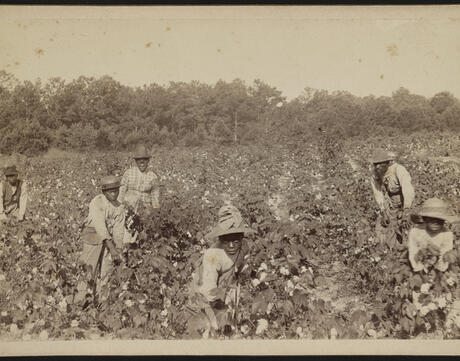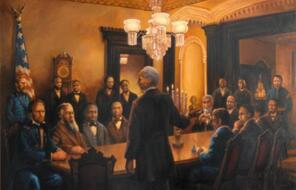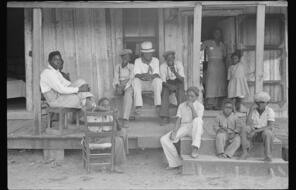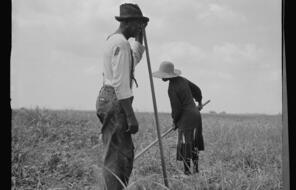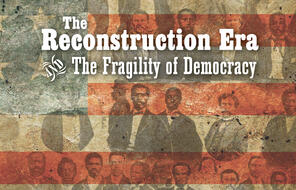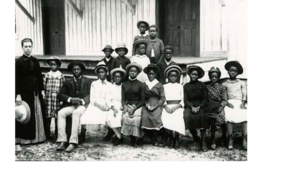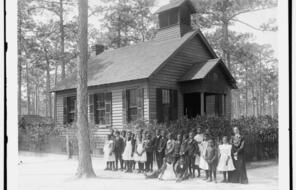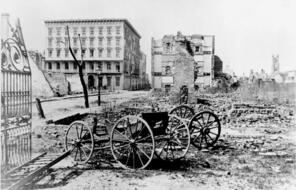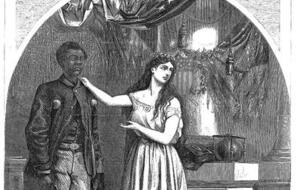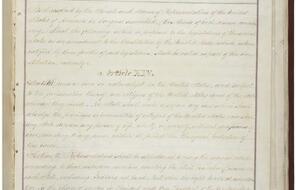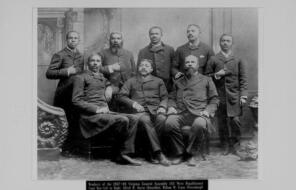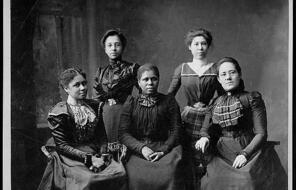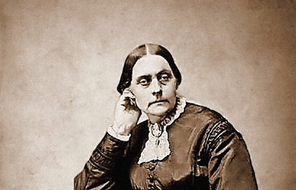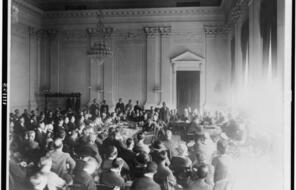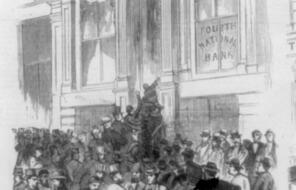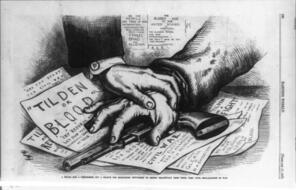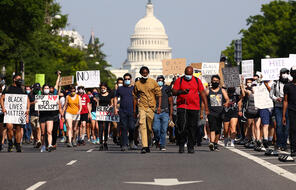Andrew Johnson began to implement his plans for Reconstruction as soon as he became president of the United States following President Lincoln’s assassination in April 1865. As students learned in the last lesson, Johnson’s plan required states of the former Confederacy to ratify the Thirteenth Amendment, which abolished slavery. However, Presidential Reconstruction also permitted most former Confederates to resume political control in their respective states and, therefore, to determine what role freedpeople would play in state politics and economics. President Johnson was not interested in expanding or protecting the political, civil, or economic rights of African Americans, and neither were the white Southerners who governed their states under Presidential Reconstruction. While it was clear to Johnson’s Radical Republican opponents in Congress that his plan would lead to the reestablishment of white supremacy, antebellum Southern aristocracy, and Democratic Party rule, they were temporarily powerless to stop the plan because Congress was in recess until December. Therefore, while Presidential Reconstruction policies were in effect, post-war Southern society began to resemble pre-war Southern society in many ways.
Land Policy and Economic Justice
In 1865, nearly all elected officials but the radical minority in the Republican Party opposed granting political rights such as the vote to freedpeople, but in the war’s closing months, a variety of policies providing some level of economic freedom and autonomy for former slaves had been implemented throughout the South. In large part, these policies were responses to two important questions students considered when they explored the aspirations of freedpeople in Lesson 3:
- What would freedpeople need in order to sustain their freedom?
- What, if anything, were freedpeople entitled to in compensation for their past labor as slaves?
One response to these questions was supplied by Union General William Tecumseh Sherman after his January 1865 meeting with freedpeople known as the Savannah Colloquy. Sherman issued Special Field Order 15 on January 16, 1865, which ordered 400,000 acres of land along the coasts of South Carolina, Georgia, and Florida to be divided into 40-acre plots and provided to freedpeople and their families. Most of this land was vacated by its owners when the Union army invaded that area early in the Civil War. On smaller scales throughout other parts of the South, freedpeople had either claimed or been granted abandoned lands in territories controlled by the Union army. But by late spring of 1865, many Southern planters were returning to reclaim the land they had left behind.
Would it be just to return confiscated and abandoned land, such as that distributed to freedpeople by Sherman’s field order, to the people who had owned it, in some cases, for generations before the war? Or would it be more just to give some or all of it to the former slaves whose families had labored on it for generations? The answers to these questions would have profound implications for how the competing demands of justice and healing would be addressed during Reconstruction. If confiscating land from Southern planters and giving it to freedpeople would be an act of justice, it would also most certainly set back the process of healing between white Americans who supported the Confederacy and those who supported the Union. How the nation resolved this dilemma would also provide evidence about how the post-war United States would define its universe of obligation.
Andrew Johnson’s Presidential Reconstruction policies addressed this dilemma over land rights and economic justice by stipulating that all property (except, of course, for slaves) be returned to former Confederates who pledged loyalty to the Union. In this lesson, students will read some protests of freedpeople as the land they had been granted was taken from them, as well as arguments explaining why they believed they had a right to the land. Students will return to their exploration of the meaning of freedom, started earlier in the unit, and seek to explain why one group of South Carolina freedpeople, upon losing their land, argued that “this is not the condition of really free men.”
Throughout the Reconstruction era, land would become a divisive issue that challenged even Republicans who advocated for full political rights for freedpeople.
“Black Codes” and Labor Contracts
Restoration of abandoned lands to their pre-war owners was only one measure the federal and state governments took during Presidential Reconstruction to ensure that white supremacy would continue in post-war Southern society. By the fall of 1865, most Southern legislatures passed laws severely restricting the freedom of Black Southerners to negotiate the terms of their labor. Known as “Black Codes,” these laws required all Black people, whether free or slave before the Civil War, to sign annual labor contracts with white employers. If they did not, or if they did not fulfill the terms of these contracts, they would be deemed vagrants and fined or imprisoned. When Black Southerners could not pay fines that resulted from breaking these or any other laws, the Black Codes permitted local sheriffs to auction them off to white citizens willing to pay the fines on their behalf, creating a system of “slavery by another name.”
Many Black Southerners, therefore, had no choice but to negotiate labor or sharecropping contracts with planters—sometimes the very planters who had enslaved them. Fairness in these negotiations was largely dependent on the goodwill of the landowner. The Freedmen’s Bureau, charged with helping to facilitate fair labor contracts between planters and freedpeople, reported widespread acrimony over these agreements. Freedpeople protested that landowners were taking advantage of them and demanding that they work more than their contracts specified. Planters’ complaints often invoked racist beliefs that Black people were lazy and disobedient. Sharecropping arrangements often left Black farmers perpetually indebted to planters and therefore tied to the land to work off a debt they could never repay.
Progress in Education
Despite obstacles created by Presidential Reconstruction policies, Black Southerners continued in crucial ways to display agency and make progress toward goals that were, perhaps, unthinkable only a few years prior to 1865. Education was one area in which freedpeople made notable progress during Presidential Reconstruction. Indeed, freedpeople followed through on the pledges made by the South Carolina Freedmen’s Convention, which declared that “knowledge is power” in its November 1865 resolution (included in Lesson 2).
In this lesson, students will read an excerpt from a January 1866 report by a Freedmen’s Bureau inspector who estimates that freedpeople had created 500 schools in the South, supporting 125,000 students, without assistance from state or federal governments. The schools were in addition to the government-funded schools, numbering more than 1,000, established in the South by the Freedmen’s Bureau in the late 1860s. The effects of the establishment of schools for freedpeople were significant. Historian Douglas Egerton writes: “Black literacy increased four hundred percent in the thirty-five years after Appomattox, a triumph not witnessed by any other nineteenth-century post-slavery society.”
It is important for students to see that, even as political, civil, and economic rights were denied to freedpeople in states across the South in the first years after the Civil War, Black Southerners continued to strive for better lives for their families, and in some ways they succeeded.
Andrew Johnson introduced his Reconstruction policies in May 1865, while Congress was in recess. By the time Congress returned to session in December 1865, Johnson declared that the task of Reconstruction was complete. But Republicans surveyed the status of freedpeople and former Confederates in the South and openly wondered who had really won the Civil War. Radicals, and eventually an increasing number of moderate Republicans, complained, as Egerton states, that Southern governments “clearly intended to devise a legal system in which blacks remained semi-enslaved, denied access to land, and relegated to a subordinate economic and social status.”
Congressmen elected by the former Confederate states traveled to Washington for the new session of Congress that December (including former Confederate Vice President Alexander Stephens, who was elected to the Senate from Georgia), but Republicans refused to seat them. A bitter political conflict between the president and the Republican Congress would ensue as Republicans began to assert their own plan for Reconstruction.
